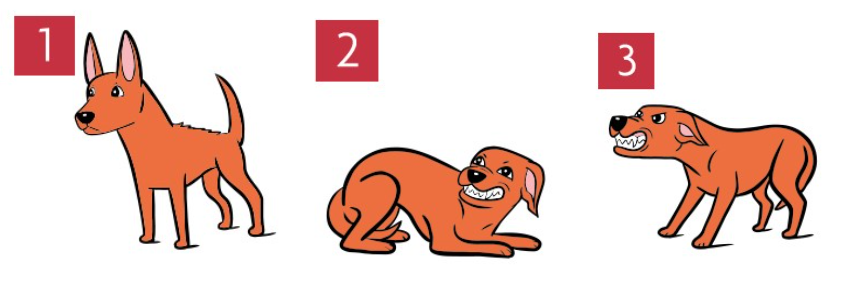A dog’s body language can be subtle, so it’s not always easy to accurately read how they’re feeling. It is important to keep an eye on your dog’s behaviour and be on the lookout for any changes, as these can be a sign that something is wrong. Use this guide to help you recognise important body language signals and get to know how your dog is feeling.
A happy dog
A dog who is happy will be relaxed.

1. Dog has a relaxed body posture and smooth hair, the mouth is open and relaxed, ears are in a natural position, the tail is wagging and the eyes are a normal shape.
2. Dog is inviting play with bottom raised, smooth hair and a high wagging tail. Eyes are a normal shape, ears are in a natural position and they may be barking excitedly.
3. Dog’s weight is distributed across all four paws, hair is smooth, tail is wagging, face is interested, alert and relaxed and their mouth is open.
A worried dog
These dogs are telling you that they’re uncomfortable and don’t want you to go near them.

1. Dog is standing but body posture and head position is low. Tail is tucked under, ears are back and the dog is yawning.
2. Dog is lying down and avoiding eye contact or turning head away from you, lip licking and with ears back.
3. Dog is sitting with head lowered, ears are back, tail tucked away, not making eye contact, yawning, raising a front paw.
An angry or very unhappy dog
These dogs aren’t happy and want you to stay away or go away.

1. Dog is standing with a stiffened body posture, weight forward, ears are up, hair raised, eyes looking at you – pupils dark and enlarged – tail is up and stiff, wrinkled nose.
2. Dog is lying down cowering, ears flat, teeth showing, tail down between legs.
3. Dog is standing with body down and weight towards the back, head tilted upwards, mouth tight, lips drawn back, teeth exposed, eyes staring, ears back and down, snarling.
If you’re concerned about your dog’s behaviour, speak to your vet first. They may refer you to an animal behaviourist.
This article is based on an article from our colleagues at RSPCA UK with illustrations © Lili Chin (www.doggiedrawings.net) and reproduced with kind permission.
